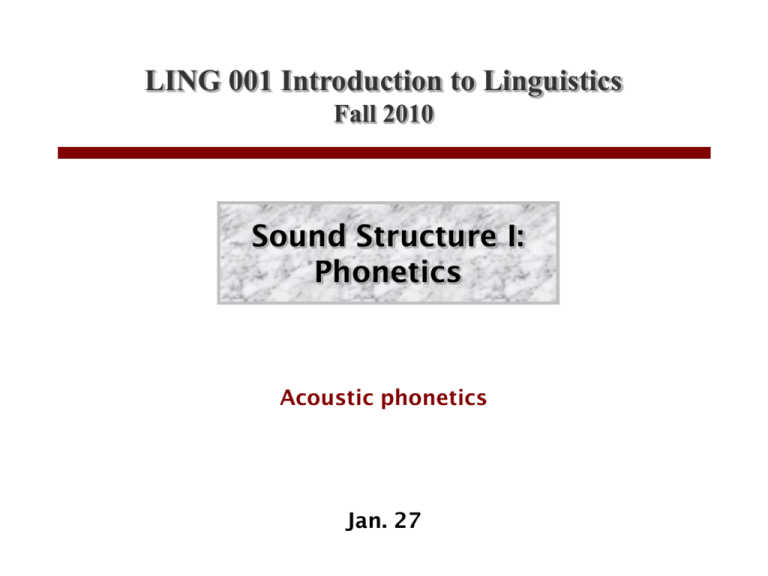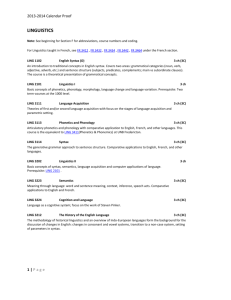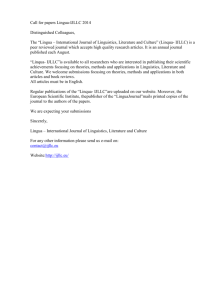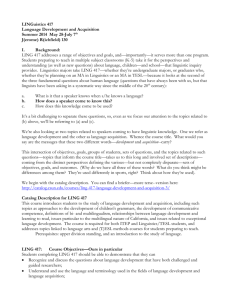ppt
advertisement

LING 001 Introduction to Linguistics Fall 2010 Sound Structure I: Phonetics Acoustic phonetics Jan. 27 Make vowel sounds from household materials Buzzing sound + Resonators QuickTime™ and a TIFF (Uncompressed) decompressor are needed to see this picture. + + QuickTime™ and a TIFF (Uncompressed) decompressor are needed to see this picture. From Mark Huckvale: http://www.phon.ucl.ac.uk/home/mark/vowels LING 001 Introduction to Linguistics, Fall 2010 = Vowels = = [a] [i] 2 The source in speech production • The production of speech consists of two kinds of operations: (1) the generation of sound sources (the raw material), and (2) the processing/resonating of these sources by the vocal tract (the resonator). • Vocal fold vibration generates buzzing sound, which is the raw material (source) for producing vowel sounds. LING 001 Introduction to Linguistics, Fall 2010 3 The vibration of the vocal folds • The aerodynamics of vocal fold vibration: With the glottis (the space between the vocal folds) closed and an airstream issuing from the lungs, the excess pressure below the glottis (sub-glottal pressure) forces the vocal folds apart; the air passing between the folds generates a Bernoulli force that quickly closes the glottis. The sub-glottal pressure builds up again, forcing the vocal folds apart again. • The vibration of the vocal folds are periodic. The frequency of the vibration is determined by the air pressure in the lungs and by the vocal folds mechanical properties. LING 001 Introduction to Linguistics, Fall 2010 4 Periodic and frequency • Vocal fold vibration is a complex periodic motion, it can be decomposed into many Simple Harmonic Motions. • Simple Harmonic Motion is the simplest periodic motion, in which a body oscillates about an equilibrium position (rest position) in a sinusoidal pattern. Tuning forks are such an example. LING 001 Introduction to Linguistics, Fall 2010 5 Simple Harmonic Motion • Properties of Simple Harmonic Motion: displacement: momentary distance from the rest point cycle: one complete oscillation amplitude: maximum displacement frequency: number of cycles per second (Hz) period: number of seconds per cycle • What is the difference? LING 001 Introduction to Linguistics, Fall 2010 6 7 Spectrum • A complex periodic motion can be represented as a spectrum showing: • Frequency of each simple harmonic component on the x-axis • Amplitude of each simple harmonic component on on the y-axis QuickTime™ and a TIFF (Uncompressed) decompressor are needed to see this picture. LING 001 Introduction to Linguistics, Fall 2010 The source spectrum in speech production • • As the vocal folds open and close, puffs of air flow through the glottal opening. The frequency of these pulses determines the fundamental frequency (F0) and contributes to the perceived pitch of the produced sound. Besides F0, the glottal air flow also contains a large number of harmonics (overtones), whose frequencies are integer multiples of F0. The amplitude of the harmonics decreases gradually. QuickTime™ and a TIFF (Uncompressed) decompressor are needed to see this picture. LING 001 Introduction to Linguistics, Fall 2010 8 Vocal tract is a resonator • • The vocal tract is a resonator. The resonance frequencies of the vocal tract, called formants, depend on its shape. The first resonance frequency is F1, the second resonance frequency is F2, and so on. The first two or three formants (their frequencies, not amplitudes) are most important in speech communication. LING 001 Introduction to Linguistics, Fall 2010 9 Final product: vowels • The presence of the formats disrupts the uniformly sloping envelop of the source spectrum, imposing peaks at the formant frequencies. Formant frequencies determine vowel quality (/i/ vs. /a/ vs. /u/ etc.) Vowel spectrum Vocal tract resonance QuickTime™ and a TIFF (Uncompressed) decompressor are needed to see this picture. Source spectrum LING 001 Introduction to Linguistics, Fall 2010 10 Acoustic vowel space LING 001 Introduction to Linguistics, Fall 2010 11 12 Vowel formants • Vowel height is closely related to the first formant frequency: low vowels -> higher F1 • Vowel frontness/backness is closely related to the second formant frequency: front vowels -> higher F2 • Formant frequencies of American English vowels (average): /i/ /a/ /u/ Male F1 270Hz F1 730Hz F1 300Hz F2 2290Hz F2 1090Hz F2 870Hz Female F1 310Hz F1 850Hz F1 370Hz F2 2790Hz F2 1220Hz F2 950Hz LING 001 Introduction to Linguistics, Fall 2010 Measuring vowel formants • Formants can be displayed by computing a spectrogram, showing the energy in the signal at different frequencies. Spectrograms are a plot of the intensity of the frequency content of a signal as time progresses. The y-axis is frequency, the x-axis is time, and the intensity is shown on a grey-scale. • Praat: doing phonetics by computer. http://www.fon.hum.uva.nl/praat/ • LING 001 Introduction to Linguistics, Fall 2010 13 The acoustics of consonants • The sources of consonant sounds are either turbulent airflow (fricatives) or release of a compressed air behind a closure (stops). The sources are aperiodic, noises. Note: White noise contains an equal distribution of energy spread over all frequencies, just as white light is composed of all of the colors of the spectrum of visible light. • The resonator is the front cavity, i.e., the part of the oral cavity that is in front of the constriction place. The nasal cavity is used as a resonator in producing nasal sounds. LING 001 Introduction to Linguistics, Fall 2010 14 15 Fricatives • Fricatives have relatively long durations of noise, and it is this lengthy interval of aperiodic energy that distinguishes fricatives as a sound class. [s, ʃ] have more energy than [f, θ]. 1 0 -1 0 4.477 Time (s) 6000 F TH S SH 0 0 4.477 Time (s) LING 001 Introduction to Linguistics, Fall 2010 16 Stops • Stops are dynamic, it has a series of ‘articulatory postures’: Gap: during closure, the only possible source is voicing (shown as a voice bar). Burst: a transient noise produced when the oral closure is released Aspiration: a diffuse noise generated at the larynx and possibly the lower pharynx. Its spectrum resembles that for the fricative [h]. • [tie], [dye], [style]. 5000 4000 Aspiration 3000 Gap 2000 1000 Burst 0 0 Time (s) LING 001 Introduction to Linguistics, Fall 2010 2.963 Voice bar VOT • To further distinguish voiced/voiceless and aspirated/unaspirated, we can use Voice Onset Time (VOT). • VOT is the duration of the period of time between the release of a plosive/stop and the beginning of vocal fold vibration. This period is usually measured in milliseconds (ms). • It is useful to distinguish at least three types of VOT which are shown in the schematic diagram below: LING 001 Introduction to Linguistics, Fall 2010 17 Speech prosody • Segments characterize speech sounds. Suprasegmental features (prosody) superimpose on segments or segmental sequences. • Acoustic cues of prosody: Pitch, determined by fundamental frequency Length, determined by duration Loudness, determined by amplitude • Stress, tone, intonation, rhythm, etc. LING 001 Introduction to Linguistics, Fall 2010 18 Tones • Tone languages use pitch to make lexical contrasts (to distinguish words). • contour tones (predominating in Chinese and the languages of southeast Asia): The tones are made up of dynamic pitch changes. • Register tone (predominating in African languages). The tones are made up of a few pitch registers: high, low, and maybe mid. LING 001 Introduction to Linguistics, Fall 2010 19 Intonation in English A: What types of foods are a good source of vitamins? B1: Legumes are a good source of vitamins. B2: Legumes are a good source of vitamins. A: I’d like to fly to Davenport, Iowa on TWA. B: TWA doesn’t fly there ... B1: They fly to Des Moines. B2: They fly to Des Moines. A1: I met Mary and Elena’s mother at the mall yesterday. A2: I met Mary and Elena’s mother at the mall yesterday. LING 001 Introduction to Linguistics, Fall 2010 20 Intonation in English 400 350 300 250 200 150 100 50 legumes are a good source of VITAMINS 400 350 300 250 200 150 100 50 LEGUMES are a good source of vitamins LING 001 Introduction to Linguistics, Fall 2010 21 Intonation in Mandarin Chinese • Interaction between tone and intonation LING 001 Introduction to Linguistics, Fall 2010 22 Rhythm • Rhythm refers to the temporal organization of speech elements. It depends on many factors. • At the segmental level, for example, vowels are longer before voiced stops than before voiceless ones. The effect is very large in English (bad vs. bat), but smaller in many other languages such as French. • At the level of syllables, languages have different phonotactic constraints on syllable shape. For example, many dialects of Chinese allow only alveolar and velar nasals in the coda position. LING 001 Introduction to Linguistics, Fall 2010 23 Rhythm • In natural speech, over 70% of French and Spanish syllables were open (e . g ., CV and V) , while more than 50% of English syllables were closed (e . g ., CVC and VC). • In Hawaiian there is never more than a single consonant between any two vowels, but in English there can be seven, as in texts spread. In Polish there are even more: LING 001 Introduction to Linguistics, Fall 2010 24







